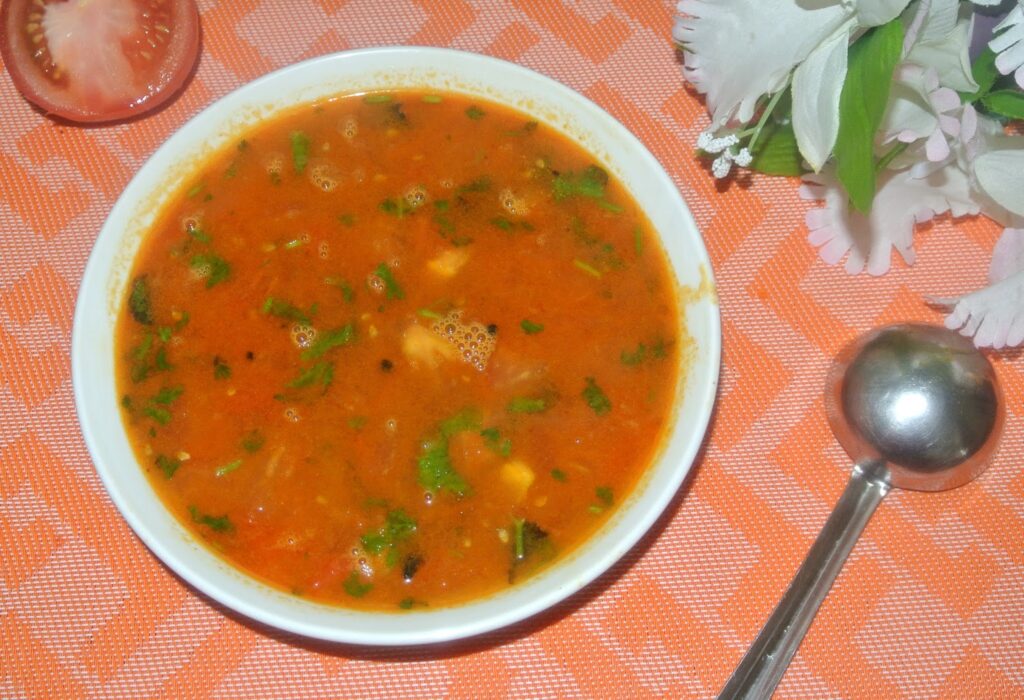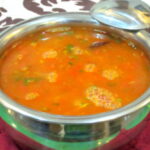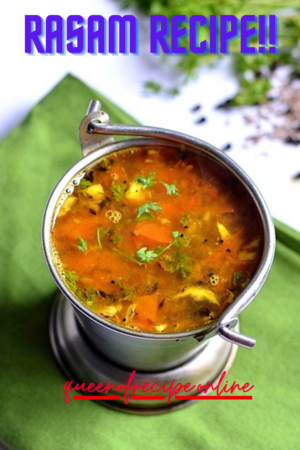Table of Contents
About Rasam
Rasam is a popular soup-like dish from South Indian Platter that is known for its tangy and spicy flavors. It is a staple in many South Indian households and is commonly served with rice. This eatable is made with a base of tamarind juice or tomato puree, which is then flavored with a blend of spices like cumin, mustard, and black pepper. The addition of curry leaves and coriander leaves enhances the flavor and aroma of it.
This dish has a rich history and has been a part of South Indian cuisine for centuries. It is believed to have originated in the southern region of India and was traditionally prepared as a medicinal soup to cure common ailments like colds and coughs. Over time, this eatable evolved to become a flavorful and beloved edible food that is enjoyed across the country.
Apart from its delicious taste, this dish also offers several health benefits. The tamarind and tomato used are rich in antioxidants and vitamins, while the blend of spices used in it, and can aid digestion and boost immunity. It is also a low-calorie and low-fat food item, making it a perfect addition to any diet.
This dish is versatile that can be customized to suit individual preferences. Some popular variations of this food item include garlic Rasam, pepper Rasam, and pineapple Rasam. Overall, it is a delicious and healthy food item that is loved by people of all ages and is an essential part of South Indian cuisine.
This dish is a popular South Indian soup-like item made with tamarind, tomatoes, and a blend of spices. Here’s a recipe for making the dish at home:
Ingredients for making it.
- 1 small lemon-sized ball of tamarind
- 2 ripe tomatoes, chopped
- 1 teaspoon cumin seeds
- 1 teaspoon mustard seeds
- 2-3 dried red chilies
- 1 sprig of curry leaves
- 1 teaspoon turmeric powder
- 1 teaspoon coriander powder
- 1 teaspoon cumin powder
- 1 teaspoon black pepper powder
- 1 tablespoon ghee or oil
- Salt to taste
- Coriander leaves for garnish
Instructions:
- Soak the tamarind in 1 cup of hot water for 10-15 minutes. Squeeze the tamarind pulp and discard the residue.
- Heat the ghee or oil in a pan over medium heat. Add the cumin seeds, mustard seeds, and dried red chilies, and sauté for 1-2 minutes.
- Add the chopped tomatoes and curry leaves, and cook until the tomatoes become soft and mushy.
- Add the turmeric powder, coriander powder, cumin powder, and black pepper powder, and sauté for 1-2 minutes.
- Add the tamarind water to the pan and bring it to a boil. Add salt to taste.
- Allow the dish to simmer for 5-10 minutes until the flavors blend well and it thickens slightly.
- Garnish with coriander leaves and serve hot with rice.
Enjoy your homemade Rasam!


Nutritional value
It is a nutritious dish that is low in calories and high in essential vitamins and minerals. The exact nutritional value of this dish can vary depending on the ingredients used, but here is a general idea of the nutrients it can provide:
- Carbohydrates: It is primarily made with tamarind juice or tomato puree, which are both sources of carbohydrates. A serving of it can provide around 10-15 grams of carbohydrates.
- Protein: It does not contain a significant amount of protein. However, the addition of lentils or dal in the recipe can increase its protein content.
- Fiber: The tamarind used in it is a good source of dietary fiber, which can aid digestion and promote satiety.
- Vitamins: It is rich in several vitamins, including vitamin C from tamarind and tomatoes, vitamin A from curry leaves and coriander leaves, and B vitamins from the spices used.
- Minerals: It contains several essential minerals like iron, calcium, and potassium. The spices used it, like cumin and black pepper, are also rich in minerals.
Overall, it is a healthy and nutritious dish that can provide a range of essential nutrients to the body. However, it is important to use fresh and natural ingredients in the recipe to maximize its nutritional value.
Health Benefits of Rasam
It, a popular South Indian soup, offers several health benefits due to its nutritious ingredients and unique flavors:
- Digestive Aid: It contains ingredients like tamarind, cumin, black pepper, and asafoetida, which have digestive properties. These ingredients can help stimulate digestion, alleviate indigestion, and promote better gut health.
- Immune-Boosting: It typically includes ingredients such as tomatoes, garlic, and turmeric, which are rich in antioxidants and have immune-boosting properties. These components can help strengthen the immune system and protect the body against various infections and diseases.
- Hydration and Detoxification: It is a liquid-based soup that helps hydrate the body, especially during hot weather. The presence of spices and herbs in the dish, such as coriander, curry leaves, and ginger, may also support detoxification and elimination of toxins from the body.
- Nutrient-Rich: It is prepared using a variety of ingredients like tomatoes, lentils, and spices, providing essential vitamins, minerals, and antioxidants. These nutrients contribute to overall health, promoting healthy skin, improved metabolism, and better energy levels.
- Low-Calorie and Weight-Friendly: It is generally low in calories and fat, making it a suitable choice for individuals aiming to manage their weight. It is light on the stomach yet satiating due to the flavors and spices present.
While it offers several health benefits, it is important to consider individual dietary needs and preferences. Adjusting the ingredients and spice levels can help tailor the recipe to specific health goals or dietary restrictions.
Tips and Tricks
Sure! it is a traditional South Indian soup made with tamarind, tomatoes, and various spices. It is usually served with rice or can be consumed as a standalone soup. Here are some tips and tricks to make delicious Rasam:
- Tamarind: Use fresh tamarind pulp or tamarind paste for the best flavor. Soak a small ball of tamarind in warm water, extract the pulp, and discard the fibers and seeds.
- Tomatoes: Choose ripe and juicy tomatoes for a rich flavor. You can use a combination of ripe tomatoes and tamarind to balance the tanginess.
- Rasam Powder: You can buy ready-made Rasam powder from stores, or prepare your own by dry roasting and grinding red chilies, coriander seeds, cumin seeds, black pepper, and curry leaves.
- Temper the spices: Tempering or tadka is essential for enhancing the flavor of it. In hot oil or ghee, add mustard seeds, cumin seeds, dried red chilies, curry leaves, and hing (asafoetida). Allow them to crackle and release their aroma before adding to it.
- Garlic and Ginger: Adding crushed garlic and grated ginger enhances the taste and aroma of it. It also adds a touch of spiciness.
- Lentils: Some Rasam recipes include cooked lentils like toor dal or moong dal, which give the soup a thicker consistency and added nutrition.
- Jaggery: A small piece of jaggery can be added to balance the tanginess of tamarind and tomatoes and impart a subtle sweetness to it.
- Garnish: Freshly chopped coriander leaves add a burst of freshness and color to the Rasam. You can also add a few drops of ghee on top before serving.
- Dilution: It should have a slightly thin consistency, similar to a soup. Adjust the water quantity according to your preference.
- Serving: Traditionally, it is served with hot steamed rice, accompanied by a dollop of ghee. It can also be served as a soup before a meal to stimulate the appetite.
- Leftovers: Rasam tastes even better the next day as the flavors meld together. Reheat it gently and serve.
Remember, Rasam is a versatile dish, and you can experiment with the ingredients to suit your taste. Enjoy this comforting and flavorful soup!


Serving Suggestions
Rasam is a flavorful and tangy South Indian soup made with tamarind, tomatoes, spices, and herbs. Here are some serving suggestions to make the most of this delightful dish:
- With Steamed Rice: The most traditional way to enjoy rasam is by mixing it with steamed white rice. Serve a bowl of hot rasam on the side and pour it over the rice before eating. This combination makes for a comforting and satisfying meal.
- As a Soup: Serve rasam as a warm and comforting soup in a bowl. It can be enjoyed on its own as a light appetizer or as a soothing remedy for a cold or sore throat.
- With Papad or Vada: Pair rasam with crispy papadams or medu vada (lentil fritters) for a delightful contrast in textures. The crunchy papad or vada complements the tangy and spicy flavors of the rasam.
- Alongside Sambar: Rasam and sambar make a perfect combination. Serve them together in a meal, allowing people to enjoy the unique flavors of each soup.
- Accompanying a South Indian Thali: Include rasam as one of the dishes in a traditional South Indian thali (platter) along with other dishes like rice, sambar, poriyal, rasam, and yogurt-based curries.
- With Steamed Vegetables: For a healthy option, serve rasam alongside a plate of steamed or sautéed vegetables. The tangy flavor of the rasam complements the natural sweetness of the vegetables.
- Enhance with Seasonings: Before serving, you can add a tempering of mustard seeds, cumin seeds, curry leaves, and dried red chilies to enhance the aroma and taste of the rasam.
- Accompany with Pickle: Serve rasam with a side of spicy South Indian pickle for an extra burst of flavors.
- Sip in a Tumbler: In some regions, rasam is traditionally served in a small tumbler or cup, and it is sipped like a soup or beverage.
- Use as a Sauce or Dip: Rasam can be used as a tangy sauce or dip for various snacks like idli, dosa, or vada.
Remember that rasam is a versatile dish, and you can adjust the spiciness and tanginess according to your preferences. Whether you enjoy it as a soup, with rice, or as an accompaniment to other dishes, rasam is sure to delight your taste buds with its unique flavors.
FAQs
What are the types of Rasam?


There are several types of rasam, each with its own unique flavor and ingredient variations. Some common types include:
Tomato Rasam: This is the most popular and basic type of rasam made with tomatoes, tamarind, spices, and herbs like coriander leaves.
Pepper Rasam: Known for its spiciness, pepper rasam is made with a generous amount of black pepper, along with tamarind, cumin, and other spices.
Lemon Rasam: It has a tangy and refreshing taste. It is made with lemon juice, tamarind, and a blend of spices, often garnished with coriander leaves.
Garlic Rasam: As the name suggests, garlic rasam is characterized by its strong garlic flavor. It includes crushed garlic cloves, tamarind, spices, and herbs.
Mysore Rasam: This is a rich and aromatic version that includes ingredients like toor dal (pigeon pea lentils), coconut, and various spices, providing a unique flavor profile.
These are just a few examples, and there are many other regional variations of the recipe throughout South India. Each type has its own distinct taste and ingredients, offering a range of flavors to suit different preferences.
How to make Rasam thick?


To make Rasam thicker, you can try the following methods:
Increase the Dal: Adding a bit more cooked toor dal (pigeon pea lentils) to the rasam can help thicken it. Mash the dal slightly before adding it to the recipe for a thicker consistency.
Simmer and Reduce: Allow the rasam to simmer for a longer duration to evaporate excess liquid and concentrate the flavors, resulting in a thicker consistency.
Use Rice Flour or Cornstarch: Mix a small amount of rice flour or cornstarch with water to create a slurry. Add this slurry to the recipe while it is simmering, stirring continuously until it thickens to the desired consistency.
Remember, the desired thickness can vary based on personal preference. Adjust the above methods accordingly to achieve the desired texture.

